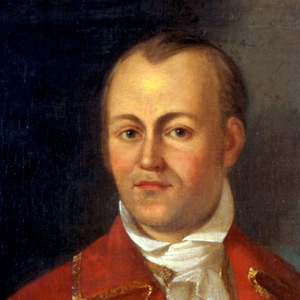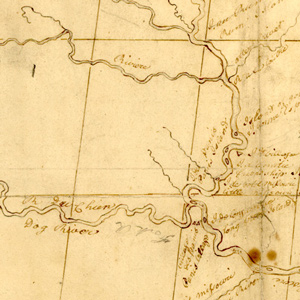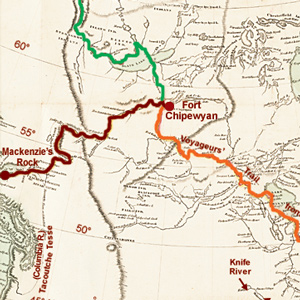The Lewis and Clark Expedition encountered numerous fur traders in the epicenter of the Spanish—and now American—trade, St. Louis. Between there and the Knife River Indian Villages in present-day North Dakota, they met many more. At the villages themselves, they met several traders from the North West and Hudson’s Bay companies. Many traders provided the captains help and information, and several were enlisted as interpreters and diplomatic envoys.
Selected Traders
Pierre Chouteau


Pierre Chouteau and his half-brother Auguste dominated the St. Louis-based fur trade when the Lewis and Clark Expedition arrived in 1803. While the expedition winter over at St. Louis, Pierre organized the first delegation of Missouri-based Indians to travel to Washington City.
Auguste Chouteau


On 28 December 1809, Toussaint Charbonneau and Sacagawea were in St. Louis to baptize their son Jean Baptiste. Auguste Chouteau was listed as the child’s Godfather and signed the baptismal record.
John Hay


With his considerable experience with Native American Nations and the Missouri-Mississippi fur trade, John Hay provided the captains significant information and advice.
René Jusseaume
One the many traders encountered at the Knife River villages, free trader René Jusseaume offered his services as an interpreter. He also accompanied Sheheke’s delegation to Washington City and thus traveled with the expedition on the final leg between the Knife River Indian Villages and St. Louis.
Charles Chaboillez
The Northwest Company manager, or bourgeois, at Fort Assiniboine was Charles Chaboillez, to whom Lewis and Clark sent a cautiously cordial letter via free trader Hugh McCracken on 31 October 1804. Chaboillez replied in due time, expressing “a great anxiety to Serve us,” Clark noted, “in any thing in his power.”
Régis Loisel
The information Loisel gave the captains seemed to take root. Throughout their journey to and from the Knife River Indian Villages, the expedition met and made use of several Loisel partners and employees: Pierre Dorion, Sr., Pierre-Antoine Tabeau, Joseph Gravelines, and Hugh Heney.
François-Antoine Larocque


The fourth literate explorer to go up the Yellowstone (and before Clark) was François-Antoine Larocque, who is important to the story of Lewis and Clark on the Middle Missouri for several reasons.
Nicholas Jarrot


Meriwether Lewis met Nicholas Jarrot in Cahokia on 7 December 1803. The next day, he and Cahokia postmaster John Hay served as translators when Lewis met the Spanish Governor of Upper Louisiana, Carlos Dehault Delassus.
Pierre-Antoine Tabeau
Tabeau was an experienced trader with the Arikara when the expedition encountered him on 9 October 1804.
Manuel Lisa
by W. Raymond Wood

After founding the Missouri Fur Company (1807-1814) Lisa made four trips up the Missouri and Yellowstone rivers to exploit the richness of the northern Rockies, and he dominated the upriver trade until 1820, two years before his death.
Lewis Crawford
In April 1804, trader Lewis Crawford was asked by Meriwether Lewis to be a diplomatic envoy to the Iowas and Yanktonai Sioux. Lewis gave Crawford a “parole and speech” and blank Indian vocabulary forms.
Hugh Heney
by Joseph A. MussulmanHeney expressed his willingness to help the Americans in dealing with the Indians—perhaps seeing this as a way of subverting the Hudson’s Bay Company’s power among the Indians in that part of the continent.
Charles McKenzie
Charles McKenzie was a clerk for the North West Company assigned to the Knife River Villages in the winter of 1804–05. His journal provides useful information about the Missouri tribes as well as the expedition’s stay at Fort Mandan. Several excerpts are included on this site.
Toussaint Charbonneau
by Barbara Fifer

The fur trade had put Charbonneau in place to meet the captains and join their expedition. He was the oldest expedition member would outlive most of his fellows as he followed the rigorous life of a fur trader, guide, and interpreter.
Charles Gratiot
Charles Gratiot was a fur trader in Illinois before moving to St. Louis in 1781. There, he married into the Chouteau family and became one of the town’s most prominent citizens. During the winter of 1803–04, he was especially helpful to the expedition and a key actor in the transfer of Upper Louisiana.
Pierre Dorion, Sr.


Dorion had previously lived with the Yankton Sioux for twenty years, and he proved to be a gifted interpreter and knowledgeable diplomat. The captains commissioned him achieve their objectives for the Yankton Sioux.
James Mackay
Showing the way


James Mackay provided the captains the most current and accurate map and information about the upper Missouri River available.


The life and times of these three explorers intertwined in a number of odd and interesting ways, often brought together by far-reaching hand of Thomas Jefferson. Tracing these connections opens a window onto every conceivable aspect of the period.


He was the first literate traveler to cross the North American continent north of Mexico, beating Meriwether Lewis and William Clark by nearly 12 years. The Lewis and Clark journals often echo Mackenzie’s journal.
Experience the Lewis and Clark Trail
The Lewis and Clark Trail Experience—our sister site at lewisandclark.travel—connects the world to people and places on the Lewis and Clark Trail.
Discover More
- The Lewis and Clark Expedition: Day by Day by Gary E. Moulton (University of Nebraska Press, 2018). The story in prose, 14 May 1804–23 September 1806.
- The Lewis and Clark Journals: An American Epic of Discovery (abridged) by Gary E. Moulton (University of Nebraska Press, 2003). Selected journal excerpts, 14 May 1804–23 September 1806.
- The Lewis and Clark Journals. by Gary E. Moulton (University of Nebraska Press, 1983–2001). The complete story in 13 volumes.

